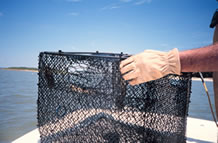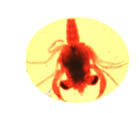|
       

|
top
Harvesting
Blue Crabs
- 95% of blue crabs are caught
with a crab pot, a baited cage that allows small crabs to escape while
keeping large ones

Crab Pot, Photo courtesy of NOAA photo library
Before 1999
- From 1987-1999, commercial landings continuously increased
- In 1999, three consecutive hurricanes hit the coast of NC, causing
massive flooding. Catch efficiency increased 369%.
- Blue crabs may have been easier to catch in 1999 as a result of
the flooding concentrating blue crabs to small pockets of higher salinity
water
2000-2002
- Overall abundance down 73% from previous 10 year average, in terms
of catch per unit effort (CPUE)
- Blue crab spawning stock catch per unit effort at historically low
levels, 72% below the previous 10 year average
- Young of the Year (YOY) catch per unit effort down 64% from
previous 10 year average
- Postlarval settlement down 84% from the 1996-1999 average

Data obtained from fishery dependent sources
- Decrease is seen in average size of mature females (from 1996-2002)
- An increase is seen in the proportion of extremely small mature
females (from 1996-2002)
2003-2004
- During 2003 spawning stock biomass returned to average levels, but declined to low levels in 2004.
- Postlarval settlement remains low, possibly indicating that the
blue crab population has not returned to pre-2000 levels.
- More detailed information on the status of the NC blue crab opulation may be found at http://www.ncseagrant.org/elements/research_files/00FEG11.pdf
- As more information becomes available in 2005, we will better understand
if the blue crab population is recovering or remaining at historically low levels.
top
|





